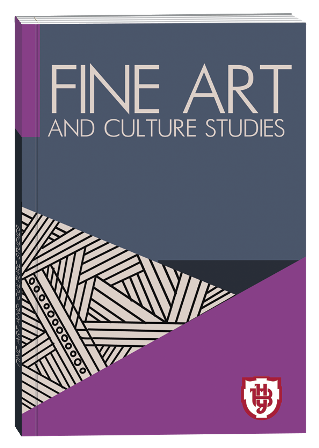THE COMMUNICATIVE NATURE OF DANCE: THE SEMIOTIC ASPECT
DOI:
https://doi.org/10.32782/facs-2024-2-16Keywords:
dance, communication, semiotic analysis, sign, symbol, cultural code, plastic code.Abstract
The article examines the communicative potential of dance as a cultural phenomenon. Dance vocabulary is explained as a type of non-verbal language capable of expressing human thoughts and feelings, symbols and codes of the collective unconscious, cultural identity, all the nuances of human experiences of events in the surrounding world, including the traumatic experience of war. The purpose of the paper is to analyze figurative and plastic communication in dance based on a structural-semiotic approach. Methodology. Semiotic analysis became the main methodological approach in the study of the communicative nature of dance. A structural method, a systematic approach, and a method of terminological analysis were also used. Scientific novelty. For the first time, the main elements of the structure of the communicative process in dance are defined and analyzed based on the semiotic approach. The explanation of the concept of "cultural code", on the basis of which the meaning of the choreographic text is deciphered, is deepened, the peculiarities of the plastic dance code are highlighted. Conclusions. The non-verbal sign-symbolic language of dance, rooted in the archetypes of traditional culture, developed under the influence of worldview, socio-cultural, ethno-national factors. The main elements of the symbolic and communicative system of dance are gestures, facial expressions and body postures, which are complemented by the semantics of the costume and dance attributes. A dance phrase is formed from a certain sequence of gestures, which not only expresses the meaning, but is also the basis of a dance artistic image. A consistent collection of phrases forms a coherent artistic text – a choreographic composition, which represents the content of the dance in the diversity of its socio-cultural functions. The expressive language of dance overcomes verbal communication barriers and contributes to the establishment of intercultural dialogue, transmitting cultural meanings and meanings in the most expressive and accessible form for perception and understanding.
References
Герц І. Культурологічні засади вивчення танцю як форми комунікації. Альманах "Культура і Сучасність". 2018. Вип. 1. С. 63–68. DOI: https://doi.org/10.32461/2226-0285.1.2018.148184.
Герчанівська П. Е. Культурна ідентичність як ресурс суспільного розвитку. Культура і сучасність: альманах. 2021. № 2. С. 3–9.
Головей В. Ю. Семіотика візуальних мистецтв: проблема знаково-символічної репрезентації. Науковий вісник Волинського національного ун-ту імені Лесі Українки. Філософські науки. 2016. № 5. С. 230–234.
Гордєєв В. Український народний танець на Поліссі: регіональні особливості лексики: дис. ... канд. мистецтвознавства.: 26.00.01. Прикарпатський національний університет ім. В. Стефаника. Івано-Франківськ, 2020. 230 с.
Жуйсюе Ч., Водяна В. Естетика українського народного традиційного танцю: семіотичний підхід. Укр. культура: минуле, сучасне, шляхи розвитку. Напрям: Мистецтвознавство : наук. зб. 2021. Вип. 38. С. 139–145. DOI: https://doi.org/10.35619/ucpmk.v38i.481.
Кіндер К. Р. Семантика пластичних символів народної танцювальної культури українців: автореф. дис... канд. мистецтвознавства: 17.00.01. Київський національний ун-т культури і мистецтв. К., 2007. 19 с.
Композиція. Енциклопедія сучасної України. Т. 14. URL: https://esu.com.ua/article-4386 (дата звернення: 19.14.2024).
Павлюк Л. Знак, символ, міф у масовій комунікації. Львів: ПАІС, 2006. 120 с.
Сільченко Т. І. Жест у пластиці рук як прийом художньої виразності в контексті образотворчого мистецтва: типологічний аспект. Науковий вісник Київського національного університету театру, кіно і телебачення імені І. Карпенка-Карого. 2022. № 31. С. 24–35. DOI: https://doi.org/10.34026/1997-4264.31.2022.267515.
Чепалов О. Хореологія як наука: культурологічні та мистецтвознавчі аспекти. Танцювальні студії. 2018. №1. С. 16–27. DOI: https://doi.org/10.31866/2616-7646.1.2018.140392.
Charles W. Morris. Writings on the General Theory of Signs. The Hague: Mouton, 1971. 485 p. URL: https://www.degruyter.com/document/ doi/10.1515/9783110810592.415/html (дата звернення: 19.04.2024).
Hyatt J., Simons H. Cultural Codes – Who Holds the Key? The Concept and Conduct of Evaluation in Central and Eastern Europe. Evaluation. 1999. №5 (1). P. 23–41. DOI: https://doi.org/10.1177/13563899922208805.
Peirce’s Theory of Signs. Cambridge: Cambridge University Press. 2007. URL: https://plato.stanford.edu/entries/peirce-semiotics/ (дата звернення: 19.04.2024).
Pejoska J., Durall E., Bauters M., Leinonen T. Culture coding. International Journal of Design Creativity and Innovation. 2022. №10 (3). P. 161-178. DOI: https://doi.org/10.1080/21650349.2022.2074144.
Short T. Peirce’s Theory of Signs. Cambridge: Cambridge University Press, 2007. 374 р. URL: https://www.cambridge.org/core/books/peirces-theory-of-signs/4AEB836491A1DC23F5CAB20E4A630919 (дата звернення: 19.04.2024).







